Rudolf, Crown Prince of Austria
Rudolf, Crown Prince of Austria (Rudolf Franz Karl Joseph; 21 August 1858 – 30 January 1889), was the only son and third child of Emperor Franz Joseph I and Elisabeth of Bavaria. He was heir apparent to the Imperial throne of the Austro-Hungarian Empire from birth. In 1889, he died in a suicide pact with his mistress, Mary Freiin von Vetsera, at the Mayerling hunting lodge.[1] The ensuing scandal made international headlines. He was named after the first Habsburg King of Germany, Rudolf I, who reigned from 1273 to 1291.[2]
| Rudolf | |||||
|---|---|---|---|---|---|
| Crown Prince of Austria Prince Royal of Hungary and Bohemia | |||||
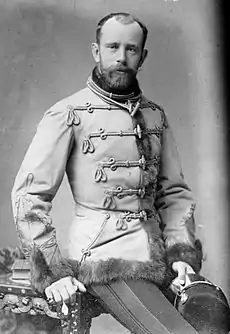 | |||||
| Born | 21 August 1858 Schloss Laxenburg, Laxenburg, Lower Austria, Austrian Empire | ||||
| Died | 30 January 1889 (aged 30) Mayerling, Lower Austria, Austria-Hungary | ||||
| Burial | |||||
| Spouse | |||||
| Issue | Archduchess Elisabeth Marie | ||||
| |||||
| House | Habsburg-Lorraine | ||||
| Father | Franz Joseph I of Austria | ||||
| Mother | Elisabeth of Bavaria | ||||
| Religion | Roman Catholicism | ||||
| Austrian Royalty |
| House of Habsburg-Lorraine |
|---|
.svg.png.webp) |
| Francis I (Francis II, Holy Roman Emperor) |
|
| Ferdinand I |
| Franz Joseph I |
|
| Charles I |
|
Background

Rudolf was born at Schloss Laxenburg,[3] a castle near Vienna, as the son of Emperor Franz Joseph I and Empress Elisabeth. Influenced by his tutor Ferdinand von Hochstetter (who later became the first superintendent of the Imperial Natural History Museum), Rudolf became very interested in natural sciences, starting a mineral collection at an early age.[3] After his death, large portions of his mineral collection came into the possession of the University for Agriculture in Vienna.[3]
In 1877, the Count of Bombelles was master of the young prince. Bombelles was the former custodian of his aunt Empress Charlotte of Mexico.[4]
Rudolf was raised together with his older sister Gisela and the two were very close. At the age of six, Rudolf was separated from his sister as he began his education to become a future Emperor of Austria. This did not change their relationship and Gisela remained close to him until she left Vienna upon her marriage to Prince Leopold of Bavaria.
In contrast with his deeply conservative father, Rudolf held liberal views that were closer to those of his mother.[5] Nevertheless, his relationship with her was, at times, strained.[5]
Marriage
In Vienna, on 10 May 1881, Rudolf married Princess Stéphanie of Belgium, a daughter of King Leopold II of the Kingdom of Belgium, at the Augustinian Church in Vienna. Although their marriage was initially a happy one, by the time their only child, the Archduchess Elisabeth, was born on 2 September 1883, the couple had drifted apart, and he found solace in drink and other female companionship. Rudolf started having many affairs, and wanted to write to Pope Leo XIII about the possibility of annulling his marriage to Stéphanie, but the Emperor forbade it.[5] In 1886, the spouses were diagnosed with gonorrhea, which rendered Stéphanie sterile.[6]
Affairs and suicide
In 1886, Rudolf bought Mayerling a hunting lodge.[7] In late 1888, the 30-year-old Crown Prince met the 17-year-old Marie Freiin von Vetsera, known by the more fashionable Anglophile name Mary, and began an affair with her.[8] On 30 January 1889, he and the young Freiin (Baroness) were discovered dead in the lodge as a result of an apparent joint suicide. As suicide would prevent him from being given a church burial, Rudolf was officially declared to have been in a state of "mental unbalance", and he was buried in the Imperial Crypt (Kapuzinergruft) of the Capuchin Church in Vienna. Vetsera's body was smuggled out of Mayerling in the middle of the night and secretly buried in the village cemetery at Heiligenkreuz.[7][9] The Emperor had Mayerling converted into a penitential convent of Carmelite nuns and endowed a chantry so that daily prayers would eternally be said by the nuns for the repose of Rudolf's soul.[10]
Vetsera's private letters were discovered in a safe deposit box in an Austrian bank in 2015, and they revealed that she was preparing to commit suicide alongside Rudolf, out of love.[11]
Effect of Rudolf's death
Rudolf's death plunged his mother into despair. She wore black or pearl grey, the colours of mourning, for the rest of her life and spent more and more time away from the imperial court in Vienna. Empress Elisabeth was murdered while abroad in Geneva, Switzerland, in 1898 by an Italian anarchist, Luigi Lucheni.[12]
Politically, Rudolf's death left Franz Joseph without a direct male heir. Franz-Joseph's younger brother, Archduke Karl Ludwig, was next in line to the Austro-Hungarian throne,[13] though it was falsely reported that he had renounced his succession rights.[14] In any case, his death in 1896 from typhoid made his eldest son, Archduke Franz Ferdinand, the new heir presumptive. In 1914, the assassination of Archduke Franz Ferdinand precipitated World War I. Emperor Franz-Joseph died in November 1916 and was succeeded by his grandnephew, Karl I of Austria. The demands of American President Woodrow Wilson forced Emperor Karl to renounce involvement in state affairs in Vienna in early November 1918. As a result, the Austro-Hungarian Empire ceased to exist and a republic came into being without revolution. Karl and his family went into exile in Switzerland after spending a short time at Castle Eckartsau.
In popular culture
- Mayerling, a film directed by Anatole Litvak, with Charles Boyer and Danielle Darrieux, based on a novel by Claude Anet.
- Sarajevo (1940), a film directed Max Ophüls starts with Rudolf's death.
- The musical Marinka (1945), with book by George Marion Jr., and Karl Farkas, lyrics by George Marion, Jr., music by Emmerich Kalman.
- Rudolf appears in the Austrian film Der Engel mit der Posaune (1948) and in the British remake of that film, The Angel with the Trumpet (1950).
- Mayerling, a 1968 film, starring Omar Sharif as Crown Prince Rudolf, Catherine Deneuve as Mary with James Mason as Kaiser Franz Josef and Ava Gardner as Empress Elisabeth.
- Japanese Takarazuka Revue's "Utakata no Koi"/"Ephemeral Love", based on the 1968 film.
- Requiem for a Crown Prince, one-hour episode of the British documentary/drama series Fall of Eagles (1974), directed by James Furman and written by David Turner, tracks in detail the events of 30 January 1889 and the following few days at Mayerling.
- Miklós Jancsó's 1975 film Vizi privati, pubbliche virtù (Private Vices, Public Virtues), a reinterpretation in which the lovers and their friends are murdered by imperial authorities for treason and immorality.
- Kenneth MacMillan's 1978 ballet, Mayerling.
- Rudolf appears as a character in the musical Elisabeth (1992)
- Rudolf appears as a character in Lillie, played by Patrick Ryecart, Granada TV's dramatisation of the life of Lillie Langtry.
- Japanese manga by Higuri You, "Tenshi no Hitsugi" (Angel's Coffin) (2000).
- The Crown Prince, film directed by Robert Dornhelm (2006) in two parts.
- Composer Frank Wildhorn's musical Rudolf – Affaire Mayerling (2006), produced in some territories as The Last Kiss or Rudolf – The Last Kiss.
- The play Rudolf (2011) by David Logan dramatises the last few weeks of the life of Crown Prince Rudolf.[15]
- A highly fictionalized version of the incident at Mayerling is depicted in the 2006 film The Illusionist. Crown Prince Leopold (played by Rufus Sewell) is a fictional analog of Rudolf.
Titles, styles and honours
Titles and styles
- 21 August 1858 – 30 January 1889: His Imperial and Royal Highness The Crown Prince of Austria, Hungary, Bohemia and Croatia[16]
Honours
- Domestic[17]
- Knight of the Golden Fleece, 1858[18]
- Grand Cross of St. Stephen, 1877[19]
- Foreign[17]
.svg.png.webp) Baden:[20]
Baden:[20]
- Knight of the House Order of Fidelity, 1873
- Grand Cross of the Zähringer Lion, 1873
.svg.png.webp) Bavaria: Knight of St. Hubert, in Diamonds, 1868[21]
Bavaria: Knight of St. Hubert, in Diamonds, 1868[21].svg.png.webp) Belgium: Grand Cordon of the Royal Order of Leopold, 1880 – wedding gift[22]
Belgium: Grand Cordon of the Royal Order of Leopold, 1880 – wedding gift[22].svg.png.webp) Brazil: Grand Cross of the Southern Cross
Brazil: Grand Cross of the Southern Cross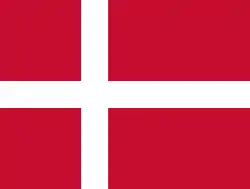 Denmark: Knight of the Elephant, 24 November 1873[23]
Denmark: Knight of the Elephant, 24 November 1873[23].svg.png.webp)
.svg.png.webp)
.svg.png.webp) Ernestine duchies: Grand Cross of the Saxe-Ernestine House Order
Ernestine duchies: Grand Cross of the Saxe-Ernestine House Order.svg.png.webp) France: Grand Cross of the Legion of Honour
France: Grand Cross of the Legion of Honour.svg.png.webp) Greece: Grand Cross of the Redeemer
Greece: Grand Cross of the Redeemer Hesse and by Rhine: Grand Cross of the Ludwig Order, 21 August 1865[24]
Hesse and by Rhine: Grand Cross of the Ludwig Order, 21 August 1865[24]_crowned.svg.png.webp) Italy: Knight of the Annunciation, 6 May 1881[25]
Italy: Knight of the Annunciation, 6 May 1881[25]
.svg.png.webp) Sovereign Military Order of Malta: Bailiff Grand Cross of Honour and Devotion
Sovereign Military Order of Malta: Bailiff Grand Cross of Honour and Devotion.svg.png.webp) Japan: Grand Cordon of the Order of the Chrysanthemum, 14 February 1881[27]
Japan: Grand Cordon of the Order of the Chrysanthemum, 14 February 1881[27] Mecklenburg: Grand Cross of the Wendish Crown, with Crown in Ore
Mecklenburg: Grand Cross of the Wendish Crown, with Crown in Ore.svg.png.webp) Mexico: Grand Cross of the Mexican Eagle, 1865[28]
Mexico: Grand Cross of the Mexican Eagle, 1865[28].svg.png.webp) Montenegro: Grand Cross of the Order of Prince Danilo I
Montenegro: Grand Cross of the Order of Prince Danilo I.svg.png.webp) Nassau Ducal Family: Knight of the Gold Lion of Nassau
Nassau Ducal Family: Knight of the Gold Lion of Nassau Netherlands: Grand Cross of the Netherlands Lion
Netherlands: Grand Cross of the Netherlands Lion.svg.png.webp) Ottoman Empire: Order of Osmanieh, 1st Class
Ottoman Empire: Order of Osmanieh, 1st Class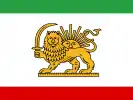 Persia: Order of the August Portrait, in Diamonds, 1 August 1873[29]
Persia: Order of the August Portrait, in Diamonds, 1 August 1873[29].svg.png.webp) Portugal: Grand Cross of the Sash of the Two Orders
Portugal: Grand Cross of the Sash of the Two Orders.svg.png.webp) Prussia:
Prussia:
- Knight of the Black Eagle
- Grand Commander of the Royal House Order of Hohenzollern
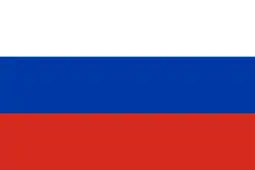 Russia:
Russia:
- Knight of St. Andrew
- Knight of St. Alexander Nevsky
- Knight of the White Eagle
- Knight of St. Anna, 1st Class
- Knight of St. Stanislaus, 1st Class
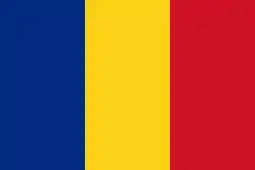 Romania: Grand Cross of the Star of Romania
Romania: Grand Cross of the Star of Romania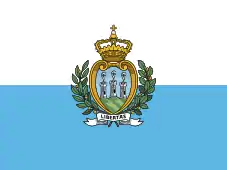 San Marino: Grand Cross of San Marino
San Marino: Grand Cross of San Marino.svg.png.webp) Serbia: Grand Cross of the Cross of Takovo
Serbia: Grand Cross of the Cross of Takovo.svg.png.webp) Saxe-Weimar-Eisenach: Grand Cross of the White Falcon, 1873[30]
Saxe-Weimar-Eisenach: Grand Cross of the White Falcon, 1873[30].svg.png.webp) Saxony: Knight of the Rue Crown, 1876[31]
Saxony: Knight of the Rue Crown, 1876[31].svg.png.webp) Siam:
Siam:
.svg.png.webp) Spain: Grand Cross of the Order of Charles III, 5 June 1875[32]
Spain: Grand Cross of the Order of Charles III, 5 June 1875[32].svg.png.webp)
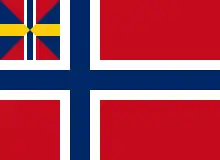 Sweden-Norway: Knight of the Seraphim, 15 April 1879[33]
Sweden-Norway: Knight of the Seraphim, 15 April 1879[33] Tunisia: Husainid Family Order, in Diamonds
Tunisia: Husainid Family Order, in Diamonds United Kingdom:
United Kingdom:
- Stranger Knight of the Garter, 20 June 1887[34]
- Gold Medal Commemorating the Golden Jubilee of Queen Victoria
 Württemberg: Grand Cross of the Württemberg Crown, 1873[35]
Württemberg: Grand Cross of the Württemberg Crown, 1873[35]
Ancestors
| Ancestors of Rudolf, Crown Prince of Austria |
|---|
Gallery
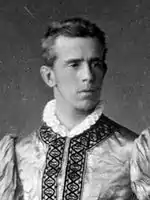 Crown Prince Rudolf during his early adulthood, c. 1879.
Crown Prince Rudolf during his early adulthood, c. 1879.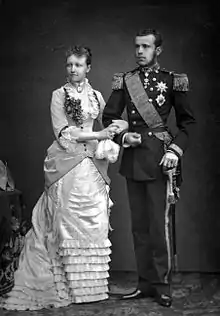 Official engagement photo of Crown Prince Rudolf and Princess Stéphanie of Belgium, 1881.
Official engagement photo of Crown Prince Rudolf and Princess Stéphanie of Belgium, 1881. Painting "Allegory on the betrothal of Crown Prince Rudolf and Stephanie of Belgium" by Sophia and Marie Görlich, dated 1881.
Painting "Allegory on the betrothal of Crown Prince Rudolf and Stephanie of Belgium" by Sophia and Marie Görlich, dated 1881.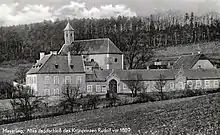 Mayerling Lodge as it appeared before Crown Prince Rudolf's death there in 1889.
Mayerling Lodge as it appeared before Crown Prince Rudolf's death there in 1889.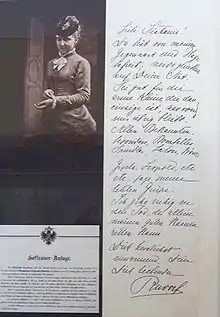 Crown Prince Rudolf's letter of farewell to his wife.
Crown Prince Rudolf's letter of farewell to his wife. Crown Prince Rudolf placed in a bed for private viewing by his family at the Hofburg Palace in Vienna. His head had to be bandaged in order to cover gunshot wounds. When he later lay-in-state, his skull was reconstructed using wax so that his appearance was normal.
Crown Prince Rudolf placed in a bed for private viewing by his family at the Hofburg Palace in Vienna. His head had to be bandaged in order to cover gunshot wounds. When he later lay-in-state, his skull was reconstructed using wax so that his appearance was normal. Crown Prince Rudolf's coffin lies to the right of his parents' coffins in the Imperial Crypt in Vienna.
Crown Prince Rudolf's coffin lies to the right of his parents' coffins in the Imperial Crypt in Vienna.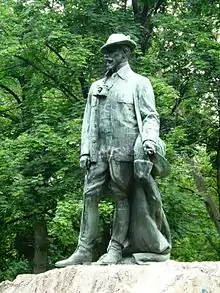 Statue in memory of Crown Prince Rudolf in the City Park of Budapest.
Statue in memory of Crown Prince Rudolf in the City Park of Budapest.
Notes
- As documented in several autograph letters by the two unfortunate lovers ANSA newsbrief (in Italian)
- Timothy Snyder (2008) 'The Red Prince, p.9. ISBN 978-0-465-00237-5
- "Crown Prince Rudolf (1858–1889)" (museum notes), Natural History Museum of Vienna, 2006, NHM-Wien-Rudolfe.
- http://www.biographien.ac.at/oebl/oebl_B/Bombelles_Karl-Albert_1832_1889.xml
- Röhl, John C. G. (29 October 1998). Young Wilhelm. ISBN 9780521497527. Retrieved 27 January 2015.
- Holler, Gerd (7 April 1980). "Bratfisch hat wundervoll gepfiffen". Der Spiegel. Retrieved 30 May 2019.
- Schmöckel, Sonja. "CSI Mayerling – How did the crown prince really die?". The World of the Habsburgs. Retrieved 29 January 2018.
- Louise of Coburg, My Own Affairs, George H. Doran Co., 1921, p.120
- Butkuviene, Gerda (11 March 2012). "Book Review: Myths of Mayerling". The Vienna Review. Retrieved 29 January 2018.
- BUTKUVIENE, Gerda (March 2011). "Book Review: Myths of Mayerling Crime at Mayerling. The Life and Death of Mary Vetsera, by Georg Markus; The Habsburgs' Tragedy, by Leo Belmonto". Falter.at.
- Press release Archived 31 July 2015 at the Wayback Machine from the Austrian National Library, 31 July 2015 (German)
- "European royalty Austria: Crown Prince Rudolf". Retrieved 27 January 2015.
- Menger, Carl (January 1994). Carl Menger's Lectures to Crown Prince Rudolf of Austria. ISBN 9781781008065. Retrieved 27 January 2015.
- "The Crown Prince's Successor". New York Times. 2 February 1889.
- http://catalogue.nla.gov.au/Record/5779956
- Kaiser Joseph II. harmonische Wahlkapitulation mit allen den vorhergehenden Wahlkapitulationen der vorigen Kaiser und Könige. Since 1780 official title used for princes ("zu Ungarn, Böhmen, Dalmatien, Kroatien, Slawonien, Königlicher Erbprinz")
- Hof- und Staats-Handbuch der Österreichisch-Ungarischen Monarchie (1889), Genealogy pp. 1–2
- Boettger, T. F. "Chevaliers de la Toisón d'Or – Knights of the Golden Fleece". La Confrérie Amicale. Retrieved 25 June 2019.
- "A Szent István Rend tagjai" Archived 22 December 2010 at the Wayback Machine
- Hof- und Staats-Handbuch des Großherzogtum Baden (1876), "Großherzogliche Orden" pp. 59, 71
- Hof- und Staatshandbuch des Königreichs Bayern: 1870. Landesamt. 1870. p. 10.
- Koophandel (De) 6 March 1880
- Jørgen Pedersen (2009). Riddere af Elefantordenen, 1559–2009 (in Danish). Syddansk Universitetsforlag. p. 472. ISBN 978-87-7674-434-2.
- Staatshandbuch für das Großherzogtum Hessen und bei Rhein (1879), "Großherzogliche Orden und Ehrenzeichen ", p. 12
- Italia : Ministero dell'interno (1884). Calendario generale del Regno d'Italia. Unione tipografico-editrice. p. 48.
- Membership of the Constantinian Order Archived 21 September 2013 at the Wayback Machine
- 刑部芳則 (2017). 明治時代の勲章外交儀礼 (PDF) (in Japanese). 明治聖徳記念学会紀要. p. 143.
- "Seccion IV: Ordenes del Imperio", Almanaque imperial para el año 1866 (in Spanish), 1866, p. 243, retrieved 29 April 2020
- Naser al-Din Shah Qajar (1874). "Chapter VI: Italy, Austria". The Diary of H.M. The Shah of Persia during his tour through Europe in A.D. 1873: A verbatim translation. Translated by James Redhouse. London: John Murray. p. 325.
- Staatshandbuch für das Großherzogtum Sachsen / Sachsen-Weimar-Eisenach (1885), "Großherzogliche Hausorden" p. 14
- Sachsen (1877). Staatshandbuch für den Freistaat Sachsen: 1877. Heinrich. p. 3.
- "Real y distinguida orden de Carlos III". Guía Oficial de España (in Spanish). 1887. p. 153. Retrieved 21 March 2019.
- Sveriges statskalender (in Swedish), 1881, p. 378, retrieved 6 January 2018 – via runeberg.org
- Shaw, Wm. A. (1906) The Knights of England, I, London, p. 68
- Hof- und Staats-Handbuch des Königreich Württemberg (1886/7), "Königliche Orden" p. 22
- Wurzbach, Constantin, von, ed. (1860). . Biographisches Lexikon des Kaiserthums Oesterreich [Biographical Encyclopedia of the Austrian Empire] (in German). 6. p. 257 – via Wikisource.
- Wurzbach, Constantin, von, ed. (1860). . Biographisches Lexikon des Kaiserthums Oesterreich [Biographical Encyclopedia of the Austrian Empire] (in German). 6. p. 227 – via Wikisource.
- Wurzbach, Constantin, von, ed. (1861). . Biographisches Lexikon des Kaiserthums Oesterreich [Biographical Encyclopedia of the Austrian Empire] (in German). 7. p. 149 – via Wikisource.
- Körner, Hans-Michael (1990), "Maximilian, Herzog in Bayern (Pseudonym Phantasus)", Neue Deutsche Biographie (NDB) (in German), 16, Berlin: Duncker & Humblot, pp. 495–496; (full text online)
- Wurzbach, Constantin, von, ed. (1860). . Biographisches Lexikon des Kaiserthums Oesterreich [Biographical Encyclopedia of the Austrian Empire] (in German). 6. p. 173 – via Wikisource.
Further reading
- Barkeley, Richard. The Road to Mayerling: Life and Death of Crown Prince Rudolph of Austria. London: Macmillan, 1958.
- Franzel, Emil. Crown Prince Rudolph and the Mayerling Tragedy: Fact and Fiction. Vienna : V. Herold, 1974.
- Hamann, Brigitte. Kronprinz Rudolf: Ein Leben. Wien: Amalthea, 2005, ISBN 3-85002-540-3.
- Listowel, Judith Márffy-Mantuano Hare, Countess of. A Habsburg Tragedy: Crown Prince Rudolf. London: Ascent Books, 1978.
- Lonyay, Károly. Rudolph: The Tragedy of Mayerling. New York: Scribner, 1949.
- Morton, Frederic. A Nervous Splendor: Vienna 1888/1889. Penguin 1979
- Rudolf, Crown Prince of Austria. Majestät, ich warne Sie... Geheime und private Schriften. Edited by Brigitte Hamann. Wien: Amalthea, 1979, ISBN 3-85002-110-6 (reprinted München: Piper, 1998, ISBN 3-492-20824-X).
- Salvendy, John T. Royal Rebel: A Psychological Portrait of Crown Prince Rudolf of Austria-Hungary. Lanham, MD: University Press of America, 1988.
External links
 Media related to Rudolf, Crown Prince of Austria at Wikimedia Commons
Media related to Rudolf, Crown Prince of Austria at Wikimedia Commons- A profile of Marie Vetsera
- IMDB on various Mayerling Films
- Crown Prince Rudolfs death
- Newspaper clippings about Rudolf, Crown Prince of Austria in the 20th Century Press Archives of the ZBW
Rudolf von Habsburg-Lorraine Cadet branch of the House of Habsburg Born: 21 August 1858 Died: 30 January 1889 | ||
| Austro-Hungarian royalty | ||
|---|---|---|
| Preceded by Ferdinand Maximilian |
Heir to the Austrian throne 21 August 1858 – 30 January 1889 |
Succeeded by Karl Ludwig |